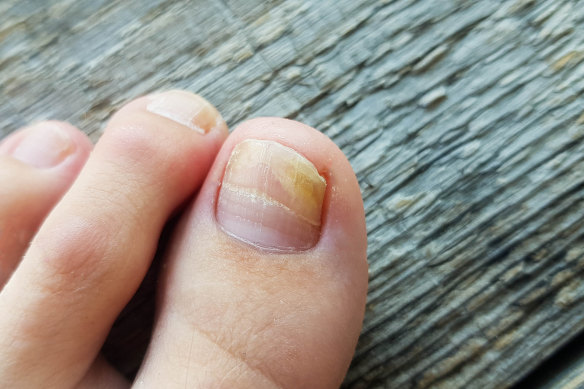The dodgy nail salon practices fuelling a surge in fungal infections
The popularity of nail salons is fuelling an explosion in fungal infections, which in extreme cases can require surgery.
While getting a pedicure or manicure used to be a treat reserved for weddings and other special occasions, they have now become a beauty staple for many Australian women.

Fungal nail infections are being linked to poor hygiene practices at beauty salons.Credit: Getty Images
Australian Podiatry Association member Georgina Jamieson estimates that up to 80 per cent of the fungal nail infections treated by podiatrists are linked to poor hygiene practices that spread infection from one customer to the next.
“These infections can cause enormous anxiety for people,” Jamieson said. “They go from feeling really confident to hiding their feet all the time.”
She said cutting cuticles or calluses without properly sterilised equipment risked transferring fungal spores and blood-borne infections.
Using the same nail polish brush for multiple clients and reusing nail files and buffer blocks were also driving up infections, Jamieson said.
According to research by IBIS World, there were 6386 nail salons and personal waxing businesses in Australia as of 2024, up from just over 5000 a decade ago.
Jamieson said that before nail salons started popping up in every shopping strip in 2003, she rarely treated clients in the 25 to 60 age bracket for fungal infections.
Her three MediPedi clinics in Adelaide now treat 10 new clients in this age group every week for fungal infections. Most attribute their infection to what is known in the industry as non-standard nail salons.
Unlike standard salons, which employ well-trained staff and often provide a wide range of beauty services, non-standard salons did not follow infection control guidelines, Jamieson said.
Treatment for a fungal nail infection usually involves topical gels and sprays, laser and, as a last resort, oral antifungal medication, which carries a risk of liver damage. In extreme cases, the nail is surgically removed.
Australian Medical Association Victorian president Jill Tomlinson, who is a hand surgeon, said she had removed patients’ nails following severe fungal infections, which they had attributed to nail salons.
“While I can remove nails, it involves more pain and disability for an individual than treating it with antifungals,” she said.
One woman, who only wanted to be referred to as Mary to protect her identity, said she had been battling a fungal nail infection for more than five years, and it had spread to nine of her toes.
Mary believes she caught the infection at a salon in 2017. She remembers her cuticles bleeding after they were cut, and then a bacterial infection developing around her big toe. In the months that followed, her nails thickened, turned white and flaked off. It’s painful for her to wear shoes because one nail has been removed and the infection puts pressure on the nail bed.
“It is very hard to get rid of,” said Mary, who has tried gels, sprays and laser to clear her nails of the infection. “My friend always warned me, ‘Don’t do it, you will get an infection.’ You never think it will be you.”
The rising popularity of nail salons has coincided with a stream of complaints to consumer watchdogs.
NSW Trading has received 154 complaints involving nail salons over the six years to 2024.
A spokesman said at least 50 complaints were about “cuts, infections, swelling or pain, and highlighted unsanitary, unhygienic or dirty equipment”.
Consumer Affairs Victoria is unable to segregate complaints about nail salons from the 1643 complaints about beauty services it has received over the past 5½ years.
While nail salons must comply with public health laws, the Australian Podiatry Association says salons are rarely audited. It is calling for mandatory training for all nail technicians and a ban on them using sharp implements.
Podiatrist Sam Brown, owner of Melbourne Podiatrists and Orthotics, supports such a crackdown.
“Patients are definitely taking some risk by going to these places,” he said. “They should be allowed to paint and polish nails only.”
Brown’s clinic treats at least one new client a week who has a fungal infection they link to non-standard nail salons.
He encourages consumers to seek help from a podiatrist if they suspect they have a fungal infection or ingrown toenail, as early treatment leads to better outcomes.
Make the most of your health, relationships, fitness and nutrition with our Live Well newsletter. Get it in your inbox every Monday.